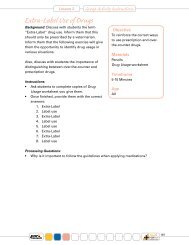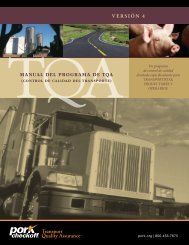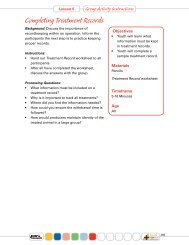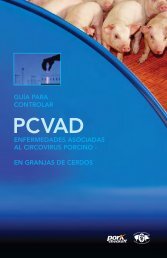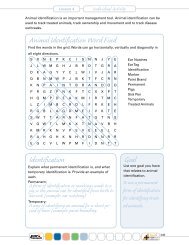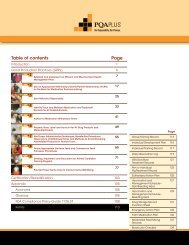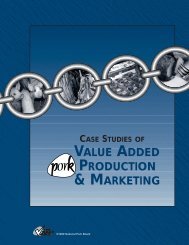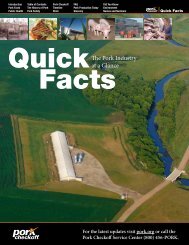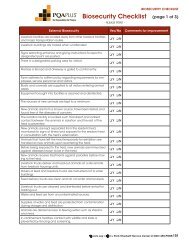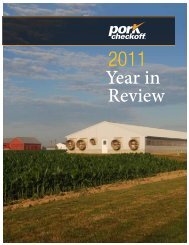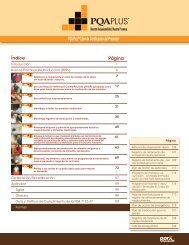PRRS Compendium Producer Edition - National Pork Board
PRRS Compendium Producer Edition - National Pork Board
PRRS Compendium Producer Edition - National Pork Board
You also want an ePaper? Increase the reach of your titles
YUMPU automatically turns print PDFs into web optimized ePapers that Google loves.
Protective immunity against re-challenge with the same <strong>PRRS</strong> virus appears to be of long duration. However,<br />
protection against challenge with different strains of <strong>PRRS</strong> virus may be variable and incomplete (Lager<br />
et al., 1999), as supported by field observations.<br />
For example, in the late summer of 1996, the number of cases of severe abortion storms in U.S. swine<br />
herds reported to diagnostic laboratories increased sharply (Halbur et al., 1997). The syndrome came to be<br />
described as “sow abortion and mortality syndrome” (SAMS) or “atypical <strong>PRRS</strong>” or “acute <strong>PRRS</strong>” by clinicians<br />
and diagnosticians. Clinical outbreaks were characterized by mid- or late-term abortions with 10-50%<br />
of the herd affected in a 1-5 week period. Sows typically were anorexic and had fevers of 104° F to 106° F<br />
for 2-4 days. Sow mortality increased with reports of losses of 5-10% of the inventory in a 1-5 week period.<br />
Increased preweaning mortality and decreased nursery pig performance, primarily due to respiratory disease,<br />
was common in these “acute <strong>PRRS</strong>” herds. Although the losses were severe, epidemiological investigations<br />
found that clinical losses associated with these outbreaks were not extraordinarily different than<br />
those observed in the late 1980’s when <strong>PRRS</strong> virus was first recognized (Bush et al., 1997). Although most<br />
of the herds had used a modified live virus (MLV) <strong>PRRS</strong> vaccine, in the majority of the cases, diagnosticians<br />
observed microscopic lesions typical of <strong>PRRS</strong> virus (interstitial pneumonia, encephalitis, myometritis)<br />
and were able to demonstrate the presence of <strong>PRRS</strong> virus antigen associated with the lesions. <strong>PRRS</strong><br />
virus was frequently isolated from the tissue or serum of affected pigs. Most <strong>PRRS</strong> virus isolates from<br />
these outbreaks were determined to be field isolates (wild type), but in some cases, the virus recovered<br />
was found to be highly similar to the MLV <strong>PRRS</strong> virus vaccine utilized in the affected herds.<br />
Isolation of vaccine-like strains of <strong>PRRS</strong> virus from cases of reproductive failure in breeding herds and/or<br />
respiratory disease in growing pigs occurs in the U.S. Experimental evidence to support vaccine-induced<br />
disease has been demonstrated in growing pigs in the U.S. (Thanawongnuwech et al., 1998a; 2000; Halbur<br />
et al., 2000). Because of these findings, there continues to be debate and discussion among researchers,<br />
diagnosticians, practitioners, and producers over the safe and efficacious use of vaccines (Key et al., 2001;<br />
Meng et al., 2000; Nielsen et al., 2001). Ultimately, practitioners and producers must weigh the risks and<br />
benefits for themselves.<br />
Summary<br />
It is clear that <strong>PRRS</strong> virus isolates vary in virulence and this may account for much of the variability in the<br />
clinical signs of <strong>PRRS</strong> in the field. The molecular tools are not yet available to predict virulence, determine<br />
the level of cross protection between <strong>PRRS</strong> virus isolates, or select the most appropriate vaccines for use<br />
in specific herds or geographic locations. Concurrent viral and bacterial co-infections can certainly influence<br />
the severity and duration of disease and mortality associated with <strong>PRRS</strong> virus infection and account<br />
for a great deal of the differences in losses attributed to <strong>PRRS</strong> from herd to herd.<br />
References<br />
Albina E, Piriou L, Hutet E, et al. 1998. Immune responses in pigs infected with porcine reproductive and respiratory syndrome virus (<strong>PRRS</strong>V). Vet Immunol<br />
Immunopath 61:49-66.<br />
Allende R, Zuckerman F, Wills RW, et al. 1999. <strong>PRRS</strong>V: Viral persistence and immune response after infection of immune competent pigs. Proceedings<br />
of the 3rd International Symposium on Porcine Reproductive and Respiratory Syndrome (<strong>PRRS</strong>), pp. 87-88.<br />
Bierk MD, Dee SA, Rossow KD, et al. 2001. Diagnostic investigation of chronic porcine reproductive and respiratory syndrome virus in a breeding herd<br />
of pigs. Vet Rec 148:687-690.<br />
Brockmeier SL, Palmer MV, Bolin SR. 2000. Effects of intranasal inoculation of porcine reproductive and respiratory syndrome virus, Bordetella bronchiseptica,<br />
or a combination of both organisms in pigs. Am J Vet Res 61:892-899.<br />
Bush EJ, Corso B, Zimmerman JJ, et al. 1997. Update on the acute <strong>PRRS</strong> investigative study. Swine Health and Production 7(4):179-180.<br />
Carvalho LFOS, Segales J, Pijoan C. 1997. Effect of porcine reproductive and respiratory syndrome virus on subsequent Pasteurella multocida challenge<br />
in pigs. Vet Microbiol 55:241-246.<br />
Christopher-Hennings J, Holler LD, Benfield DA, Nelson EA. 2001. Detection and duration of porcine reproductive and respiratory syndrome virus in<br />
semen, serum, peripheral blood mononuclear cells, and tissues from Yorkshire, Hampshire and Landrace boars. J Vet Diagn Invest 13:133-142.<br />
Clark LK. 1998. New rearing technologies: Influence on health, growth, and production economics of swine. Proceedings of the International Pig Veterinary<br />
Society Congress, Vol 1, pp. 281-288.<br />
Cooper VL, Doster AR, Hesse RA, Harris NB. 1995. Porcine reproductive and respiratory syndrome: NEB-1 <strong>PRRS</strong>V infection did not potentiate bacterial<br />
pathogens. J Vet Diagn Invest 7:313-320.<br />
PAGE 14<br />
PIG 04-01-09





